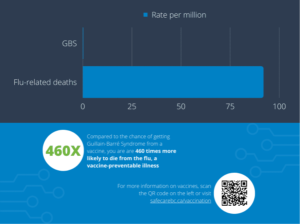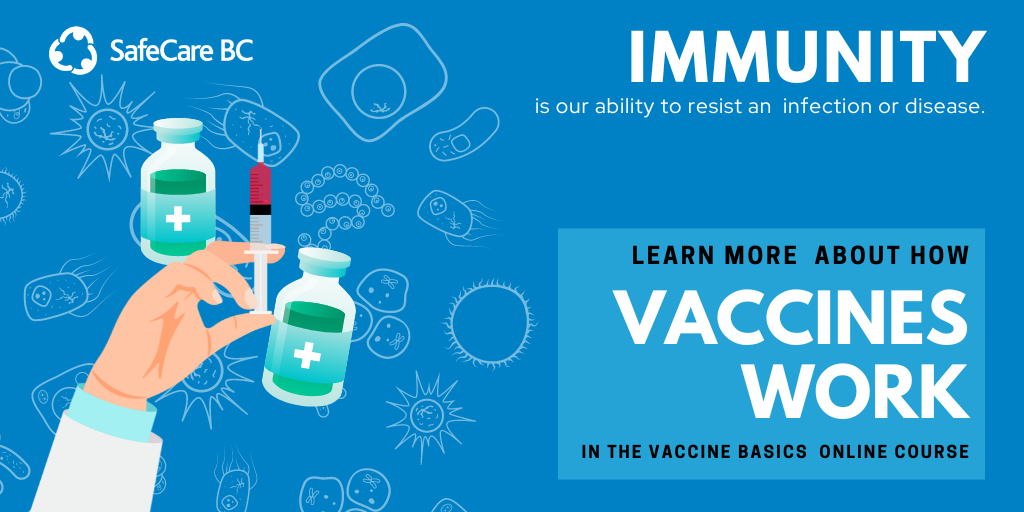The Vaccine Basics Course is a self-paced online program for students, frontline staff, support staff, and managers. This course aims to deepen your understanding of vaccines as an essential part of infection prevention and control practices. It will cover how vaccines work, how they are developed, and answer some common questions. We hope to empower users with the tools and resources needed to have well-informed, respectful conversations about vaccination in the workplace.
Many ingredients go into different vaccines that help ensure they are safe to put into our bodies, give a stronger immune response, and can last in storage, allowing large amounts to be made, shipped, and given to people around the world. By understanding the functions of these ingredients, you can better understand their purpose if you see them listed as a vaccine ingredient.
Antigens –are the active ingredient in many vaccines. Our immune system recognizes that the antigens don’t belong and either weakens or destroys them and remembers them for the future. Because they are weakened or killed, they do not cause disease in people with healthy immune systems.
mRNA –is the active ingredient in mRNA vaccines and provides our bodies with the instructions to build specific proteins associated with a disease. mRNA is found throughout our bodies, providing instructions for our cells to build different proteins. After the mRNA provides instructions to a cell, it is destroyed, so any mRNA from a vaccine is quickly destroyed after doing its job.
Adjuvants –(Examples: Aluminum salts, squalene) are used to promote a stronger immune response which means we can get better protection with smaller and fewer doses of a vaccine. Different adjuvants can be found in many vaccines. Aluminum is present in many of the foods we eat every day. The doses in vaccines are much smaller than we are likely to consume on an average day, and there are currently no health concerns associated with aluminum in vaccines. Squalene is a type of lipid or fat commonly found in the human body to help hydrate and protect the skin and can be found in many cosmetic products.
Formaldehyde – Used to kill viruses and detoxify bacteria, so you do not become sick after receiving a vaccine. A natural part of the human metabolic process is 50 to 70 times more formaldehyde present in a newborn baby than in one dose of a vaccine.
Antibiotics – Helps counter the risk of any dangerous bacterial infection from any bacteria present in the production process.
Lipids –Used in mRNA vaccines to help protect the mRNA from destructive enzymes before the mRNA enters muscle cells to work effectively.
Preservatives and Stabilizers – (Examples: Thimerosal, Gelatin, Sucrose, MSG, Tromethamine) Preservatives and stabilizers have unique functions depending on the specific ingredient. They can help prevent the growth of dangerous bacteria or fungi. Some can help the vaccine molecules from losing their shape in cold temperatures. Others can be used to help keep them effective through heat or cold and increase their shelf life. Once broken down in our body, Thimerosal turns into ethylmercury and is quickly removed from the body. Methylmercury, which has a very similar spelling, is the form of mercury commonly found in seafood and can be dangerous in large amounts. Thimerosal is not known to have any similar effects. Since the late 1960s, MSG has been considered a dangerous food additive. However, further research has shown it is safe and commonly found in popular foods such as Doritos.
When considering whether or not to receive a vaccine, it can be useful to consider what common symptoms of a disease can look like compared to what side effects can beexperienced by receiving a vaccine for that disease. Considering the severity of symptoms and the time you have with symptoms, receiving the vaccine can lead to less work missed and prevent you from becoming sick with influenza. If you become sick, having the vaccine can make you sick for a shorter time because your body already knows how to make the antibodies needed to fight the disease.
If you are also concerned about the chance of having a rare side effect, one of the possible results is Guillain-Barré Syndrome. Canada has administered over 85 million COVID-19 vaccines since December 2020, and there have been 20 reported cases causally linked to vaccines, or 0.2/1,000,000. There were 92/1,000,000 deaths associated with the flu in the 2018-19 flu season.

Compared to the chance of getting Guillain-Barré Syndrome from a vaccine, you are 460 times more likely to die from the flu.
Learn more and register for Vaccine Basics ›
There are several reasons why some vaccines may require multiple or additional doses:
Some vaccines do not provide enough antibodies after one dose and require 2- or 3- doses to obtain strong enough immunity.
With some vaccines, our protection can begin to wear off over time, at which point a “booster” dose is needed to improve immunity. We have seen this with COVID-19 possible.
Some diseases have multiple strains that require more frequent vaccine doses. Most notably, we need a new influenza vaccine each year to protect against different strains as they change over time.
Just as you need to reapply sunscreen when out in the sun for long periods, getting additional doses of vaccines when they are needed is important to keep you as protected as possible!
Learn more and register for Vaccine Basics ›
With their greater exposure to risk in the workplace, healthcare workers are often one of the first groups offered vaccines. In recent years a challenge for leaders in the sector has become combating the increase in vaccine hesitancy among staff.
Vaccine hesitancy may be due to many reasons, but most often is driven by low confidence in the safety and efficacy of the vaccine and trust in the sources of vaccine-related information. Developing effective strategies that increase vaccine confidence through education and supporting leaders to engage in positive, meaningful conversations with staff is becoming crucial.
SafeCare BC has launched a new online vaccine education program for healthcare workers and leaders as part of the Immunization Partnership Funding supported by the Public Health Agency of Canada. This program aims to provide healthcare workers with a deeper understanding of how vaccines work, address some common questions, and the skills, tools, and resources to lead well-informed, respectful conversations about vaccination in the workplace.
Healthcare workers are often a trusted public health information source and can influence vaccination uptake. Therefore, education, conversations, and building trust in vaccines with healthcare workers are essential, especially during pandemics and newly emerging diseases, to reduce hesitancy and promote safer communities.
Learn more and register for Vaccine Basics ›











